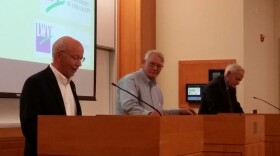Last spring, voters in two southern Oregon counties passed measures to ban the cultivation of genetically engineered crops. Now, Oregon voters statewide are being asked to approve a measure to require genetically engineered foods to be labeled. As with the similar, unsuccessful ballot measures in Washington and California, lots of out-of-state money is flooding into the campaigns on both sides.
On a recent Thursday evening, in an office suite in downtown Medford, volunteers with the GMO Right To Know campaign are hitting the phones.
Between calls, phone volunteer Pat McDonald says, to him, the issue is pretty simple.
Pat McDonald: “Everyone should have the right to know what they’re eating. Generally this is a right to know issue.”
Peggy Smith -- the Yes campaign’s southern Oregon coordinator and a cancer survivor -- echoes those concerns.
Peggy Smith: “My personal choice is, I want to err on the side of caution. And I want the information to be able to do that.”
Surveys show that consumers strongly support the idea of knowing what’s in their food. And most of the Yes on 92’s campaign advertisements focus on that “right to know” argument. On the other hand, the campaign to defeat Measure 92 is hitting hard at what it portrays as weaknesses and inconsistencies in the proposal. Dana Bieber is chief spokeperson for the No on 92 campaign.
Dana Bieber: “There are thousands of food products that actually contain GMO ingredients in them, but they get a special exemption and they wouldn’t be labeled. That’s completely misleading to consumers.”
Supporters counter that the measure uses the same GMO labeling standards used in more than 60 countries – including Japan, Brazil and the European Union, markets many US food companies already sell to … Voters in Washington will recognize Dana Bieber; she served the same role in last year’s campaign that defeated that state’s labeling proposal. Speaking from her Seattle-area home, Bieber hammers on the same points she used in Washington, including the charge that Measure 92 will hurt farmers.
Dana Bbieber: “They will have to grow and process and harvest their crops completely separate between the non-GMO and the GMO crops. They’re going to have to install separate systems. That’s expensive to farmers.”
Farmers figure prominently in ads for the No campaign, such as this ad with Katie Fast, identified as a wheat farmer in Amity, Oregon.
Katie Fast: “We’ve farmed here for three generations and have never seen anything that would hurt farmers and consumers like Measure 92.”
Fast is also Vice President of Public Policy at the Oregon Farm Bureau. The Bureau, and most large agriculture groups, oppose Measure 92. But the Yes campaign has its own roster of farmers … Steve Cohn, who farms in Talent, appears in this ad …
Steve Cohn: “Labeling helps family farmers by letting people know the difference between traditional food we grow, and food genetically engineered in a lab. Hundreds of Oregon family farmers support labelling and think you have a right to know what you’re eating.”
The drive to label genetically engineered foods is framed as a right-to-know issue. But it’s rooted in concerns about food safety and environmental impacts. There’s little scientific evidence that eating genetically engineered foods is unhealthy. George Kimbrell, with the Washington DC-based Center for Food Safety, says that could be because the federal government is dropping the ball.
George Kimbrell: “We’re part of an experiment that’s going on here because you’ve got the FDA taking Monsanto and Syngenta’s word that these foods are safe to eat and FDA is making no testing or independent study of safety themselves.”
Kimbrell’s group is a major contributor to the Measure 92 campaign … There’s more evidence to back up concerns about the environment. A report from the U-S Department of Agriculture earlier this year showed that weeds are developing a growing resistance to glyphosate, the main ingredient in Roundup. That’s the herbicide most GMO corn and soybeans are designed to tolerate. That’s led to more herbicide use. In fact, the EPA just approved genetically engineered corn and soybean products designed to tolerate a new herbicide combination needed to kill glyphosate-resistant weeds … Given the uncertainties about the impact of genetically engineered crops, Measure 92 supporters say, they’d prefer to avoid them. But No on 92 spokesperson Dana Bieber says they already can.
Dana Bieber: “We recognize there are consumers who would prefer foods without GMO ingredients in them. For them, there are already not one but two labeling standards. They can look for organic, or Non-GMO certified foods.”
The Bellingham, Washington-based non-profit that created the Non-GMO Verified label supports Measure 92, saying a voluntary certification such as theirs is not a substitute for mandatory labelling … As in the recent labeling battles in Washington and California, millions are being spent on both sides of the campaign, which is now the most expensive in Oregon’s history. Biotech giant Monsanto has dropped more than 4 million dollars into the No campaign, and other biotech and food processing firms have brought the total to nearly 11 million. All but 600 dollars of that total comes from out of state corporations. On the Yes side, California soap maker Dr. Bronner’s has given 1.2 million dollars, leading a slew of natural foods companies and consumer groups. Eighty percent of the Yes campaign’s total of five-and-a-half million dollars comes from out of state, but less than half comes from corporations … As Election Day approaches, polls show a narrowing margin of approval for Measure 92. After losing in Washington and California, anti-GMO activists are hoping the third time’s the charm and that Oregon will be the first state where voters put GMO labeling into law.
Copyright 2014 Jefferson Public Radio






